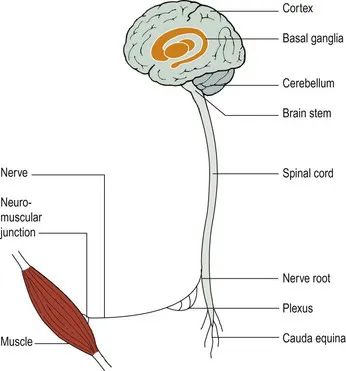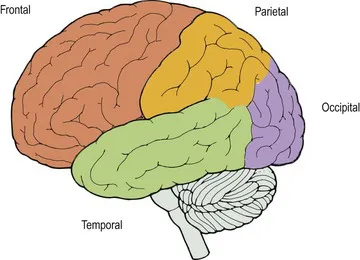
eBook - ePub
Neurology E-Book
An Illustrated Colour Text
Geraint Fuller, Mark R. Manford
This is a test
Partager le livre
- 144 pages
- English
- ePUB (adapté aux mobiles)
- Disponible sur iOS et Android
eBook - ePub
Neurology E-Book
An Illustrated Colour Text
Geraint Fuller, Mark R. Manford
Détails du livre
Aperçu du livre
Table des matières
Citations
À propos de ce livre
An introductory textbook of neurology in the Illustrated Colour Text series, making full use of all the usual features of the series - double page spreads, short paragraphs, summary boxes, attractive use of colour etc.
- Clear explanation of neurological examination - often found very taxing by students.
- Demonstrates how to approach common neurological presentations, such as blackouts and numbness, before moving on to a comprehensive coverage of syndromes and diseases.
- Concentrates on the core curriculum which the medical student really needs to know.
- Updated management in the light of new evidence and new drugs most notably in Parkinson's disease, epilepsy and multiple sclerosis.
- Images, particularly MRI scans, updated with more modern and higher resolution images.
- Includes a new double-page spread on Sleep.
- Extra material added on giddiness to include the head thrust test and Epley's manoeuvre.
Foire aux questions
Comment puis-je résilier mon abonnement ?
Il vous suffit de vous rendre dans la section compte dans paramètres et de cliquer sur « Résilier l’abonnement ». C’est aussi simple que cela ! Une fois que vous aurez résilié votre abonnement, il restera actif pour le reste de la période pour laquelle vous avez payé. Découvrez-en plus ici.
Puis-je / comment puis-je télécharger des livres ?
Pour le moment, tous nos livres en format ePub adaptés aux mobiles peuvent être téléchargés via l’application. La plupart de nos PDF sont également disponibles en téléchargement et les autres seront téléchargeables très prochainement. Découvrez-en plus ici.
Quelle est la différence entre les formules tarifaires ?
Les deux abonnements vous donnent un accès complet à la bibliothèque et à toutes les fonctionnalités de Perlego. Les seules différences sont les tarifs ainsi que la période d’abonnement : avec l’abonnement annuel, vous économiserez environ 30 % par rapport à 12 mois d’abonnement mensuel.
Qu’est-ce que Perlego ?
Nous sommes un service d’abonnement à des ouvrages universitaires en ligne, où vous pouvez accéder à toute une bibliothèque pour un prix inférieur à celui d’un seul livre par mois. Avec plus d’un million de livres sur plus de 1 000 sujets, nous avons ce qu’il vous faut ! Découvrez-en plus ici.
Prenez-vous en charge la synthèse vocale ?
Recherchez le symbole Écouter sur votre prochain livre pour voir si vous pouvez l’écouter. L’outil Écouter lit le texte à haute voix pour vous, en surlignant le passage qui est en cours de lecture. Vous pouvez le mettre sur pause, l’accélérer ou le ralentir. Découvrez-en plus ici.
Est-ce que Neurology E-Book est un PDF/ePUB en ligne ?
Oui, vous pouvez accéder à Neurology E-Book par Geraint Fuller, Mark R. Manford en format PDF et/ou ePUB ainsi qu’à d’autres livres populaires dans Medicine et Internal Medicine & Diagnosis. Nous disposons de plus d’un million d’ouvrages à découvrir dans notre catalogue.
Informations
Organization of the nervous system
The practice of clinical neurology depends on an appreciation of the structure and function of the nervous system. However, a detailed knowledge of neuroanatomy is not essential. This section will outline some of the important neuroanatomy needed for clinical neurology. Some areas, for example the anatomy of the visual system, will be described in the relevant section.
The levels of the nervous system
The nervous system is very complicated, in terms of both its structure and its physiology. Fortunately, when things go wrong they can be categorized on the basis of a relatively simple scheme of neuroanatomy. The nervous system can be thought of as having different levels (Fig. 1). The distribution and type of the clinical problem will often point to the affected level. For example, a patient who is confused must have a disturbance affecting the cerebral hemispheres. There are some situations when the level cannot immediately be determined: for example, a patient with foot drop could have a problem in the peripheral nerve, nerve root, spinal cord or cerebral hemisphere. Terminology used to describe disturbances at different levels is given in Box 1.

Fig. 1 Levels of the nervous system.
Box 1 Terminology
Abnormalities in the different levels of the nervous system can be referred to according to different terms. One commonly used system is described here. The suffix -opathy can be replaced by -itis if there is thought to be an inflammatory basis to the disturbance.










These terms can be combined with one another or other qualifiers to produce descriptions such as focal encephalopathy, or meningoencephalomyelitis (inflammation of the meninges, brain and spinal cord).
The central nervous system
The cerebral hemispheres
The cerebral hemispheres contain the apparatus of higher function. The dominant hemisphere (left in right-handed people) controls speech and the non-dominant hemisphere provides more spatial awareness. Different lobes undertake different functions (Fig. 2):





Fig. 2 Lobes of the brain.
The basal ganglia
The basal ganglia are interconnected deep nuclei including the putamen, caudate, globus pallidum and substantia nigra with complicated interrelations. They are involved in the integration of motor and sensory ...